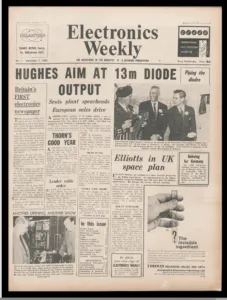In the UK, Harold Macmillian was Prime Minister, leading a conservative government; Dwight David “Ike” Eisenhower was the US president but only for the next couple of months. He and his vice-president Richard Nixon were to lose to John F Kennedy and running mate Lyndon B Johnson in November that year. The other major political power during this Cold War period was Russia, led by President Nikita Khrushchev.
The new black and white print magazine reported on news of the UK’s space industry, its telecommunications projects and early semiconductor industry.
Over the last 65 years, Electronics Weekly has charted the rise (and fall) of major companies, identifying early trends that grew into significant industry movements that shape our world today.
See also:
- Editors’ picks: Reflections on the first issue of Electronics Weekly
- From print to podcasts: 65 year-legacy of Electronics Weekly – timeline
Digital
As the world became digital, Electronics Weekly launched its website in 1999, making its news and analysis accessible to an international audience via the internet.
Then the world embraced multimedia and in 2018 Electronics Weekly introduced its EW-TV channel, which hosts video content, including interviews with exhibitors and industry commentators and reels from exhibitions and conferences.
Since 2000, Electronics Weekly‘s newsletters have enabled news stories to be brought directly into readers’ inboxes and in 2007 a digital version of the issue was introduced. The digital issue appeals to readers who want to access news, product innovations and technical features via a laptop, tablet or phone.
At the same time, it opened up the editorial content to readers outside the UK. Today, the readership is equally spread across UK and Europe, the Americas and Asia.
CHIIPs
The latest innovation, reflecting how information is consumed in the 21st century, is Electronics Weekly‘s podcast series, CHIIPs. Since March of this year, guests have shared their insights about technology, thoughts on training, recruitment and encouraging interest in STEM subjects as well as start-up and careers advice.
Electronics Weekly has adapted and evolved as the demands and tastes of readers and the industry it serves have changed. This change has meant not just a shift from monochrome paper editions to colour print and digital issues but a whole suite of ways that readers can access the information they need: online, in print or through its social media presence. Today, Electronics Weekly is still the barometer of the electronics industry. Its team of renowned and expert journalists is highly regarded for its online news updates, analysis and comment and blogs as well as professionally produced video and audio content.
Elektra Awards
Electronics Weekly also champions the industry. In 2003 it introduced the Elektra Awards, celebrating the best of design, innovation and technical excellence in the electronics industry. In 2017 Electronics Weekly introduced BrightSparks – promoting young and emerging talent in the electronics industry. And in 20024 we introduced Women Leaders in Electronics Awards, to focus the spotlight on women who have forged a career path, managed, mentored or shown entrepreneurial flair in an industry where they are often overshadowed.
Things have indeed changed a lot since 1960: then no one had heard of The Beatles, the European Economic Community was a fledging economical ideal and not every home had a landline telephone or TV.
What hasn’t changed, is Electronics Weekly‘s incisive reporting and comprehensive coverage of the electronics industry from innovations to implications, and from personalities to politics.
Electronics Weekly remains one of the longest standing and trustworthy names for anyone in the electronics industry.
Your memories
Celebrate our first 65 years with us! Tell us when you first started reading Electronics Weekly. What was the news story that got you hooked? Did you appear in Electronics Weekly? Share your stories.
Leave a comment below or share your thoughts on our LinkedIn page.

